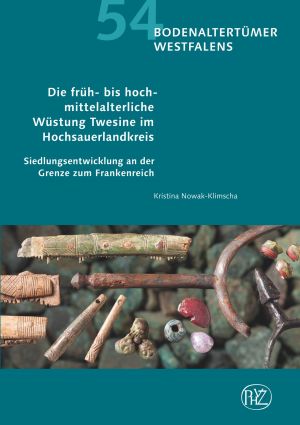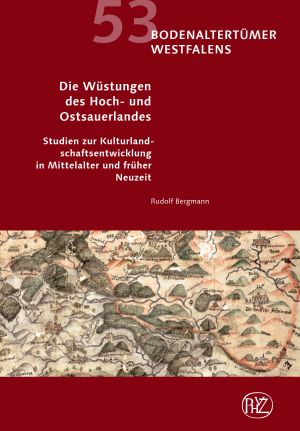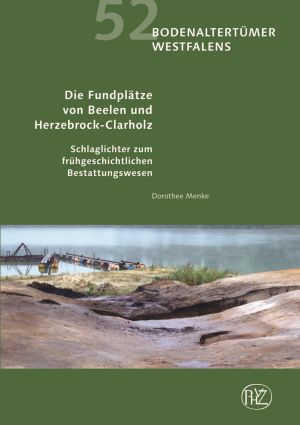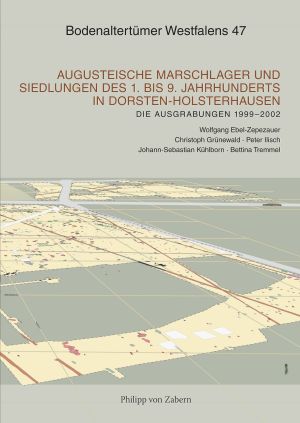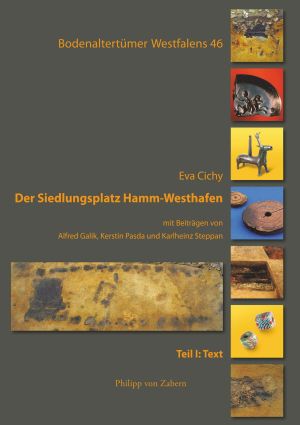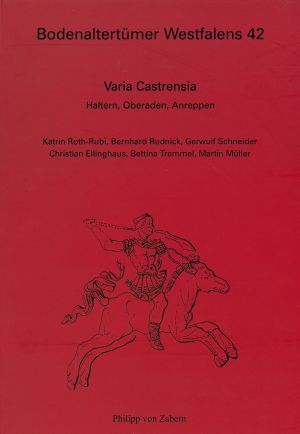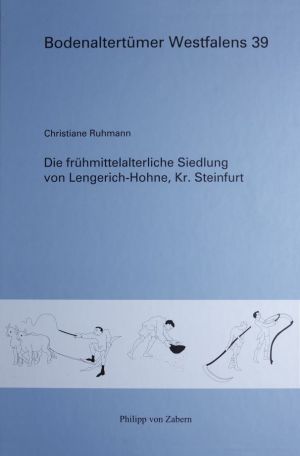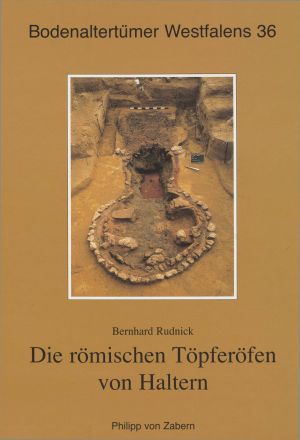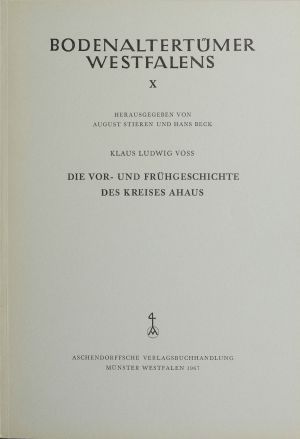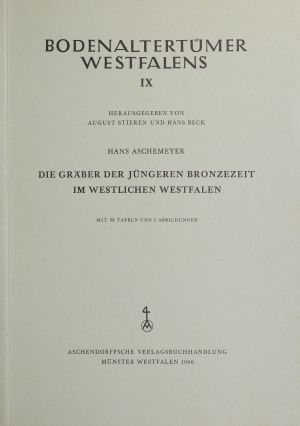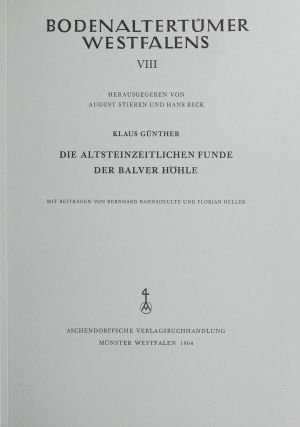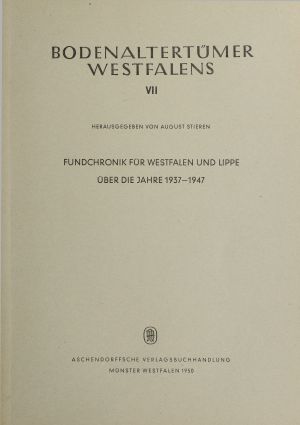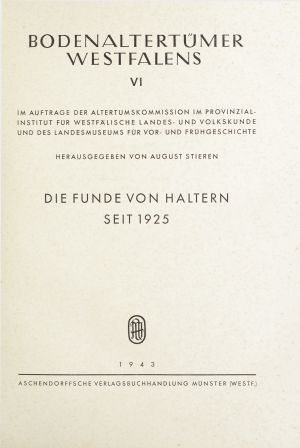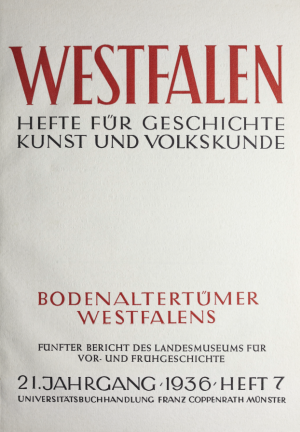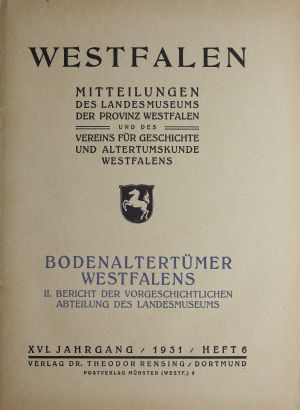Bodenaltertümer Westfalens
„Bodenaltertümer Westfalens“ (BAW) is the LWL-Archäologie für Westfalen's longest running publication series: its first volume was published in 1929. The first editions were published in close collaboration with the Altertumskommission für Westfalen in a journal called „Westfalen. Hefte für Geschichte, Kunst und Volkskunde“. Starting with volume 6 BAW has been an independent series since 1943.
The research results of the Westphalian Departement of Archaeology – dealing with single excavations as well as general questions – are published as monographs or collections of essays, covering the periods from the Paleolithic until the Early Middle Ages. The authors are the archaeologists of the LWL, Westphalian urban archeology institutes, universities and excavation companies.
The series is published irregularly and the print version is sold on a commission basis by the Verlag Dr. Rudolf Habelt. Remaining stock of several volumes is available online via Beier & Beran.
Future volumes will be published in print and will be made available on this platform in Open Access simultaneously. In the meanwhile older volumes will be digitized and – once the rights of use are granted – gradually released online.
![]()
Editors
LWL-Archäologie für Westfalen
An den Speichern 7
48157 Münster
E-Mail: lwl-archaeologie@lwl.org
Internet: www.lwl-archaeologie.de
Published so far
Die früh- bis hochmittelalterliche Wüstung Twesine im Hochsauerlandkreis: Siedlungsentwicklung an der Grenze zum Frankenreich
The early to high medieval deserted village of Twesine is situated at the foot of the mountain plateau of Eresburg Castle – today's Obermarsberg. Twesine has a special significance for the history of Westphalia, as early relics of copper smelting were discovered here. The waste products of copper and iron extraction are found in Twesine in a dump up to 60 cm high and 3000 m2 in size. They bear witness to all stages of metal processing for which the deposits at Obermarsberg were exploited. Kristina Nowak-Klimscha investigates whether the settlement and the wide-ranging metallurgical knowledge available here, together with Eresburg Castle, became a pawn in Charlemagne's power and economic-political interests during the Saxon Wars.
This thesis was accepted as a dissertation at the Ruhr-Universität Bochum in 2014.
Die Wüstungen des Hoch- und Ostsauerlandes: Studien zur Kulturlandschaftsentwicklung in Mittelalter und früher Neuzeit
Deserted sites – rural settlements abandoned in the Middle Ages – are an important but often neglected factor in the development of today's cultural landscape. The research of the author Rudolf Bergmann, which is supported by the European funding program LEADER, is dedicated to these deserted sites. For the first time all references to the abandoned places of the Middle Ages in the area of the modern Hochsauerland and Ostsauerland around the six towns of Brilon, Hallenberg, Medebach, Marsberg, Olsberg and Winterberg are brought together in one volume.
The main part of the work is a catalog of almost 400 pages. There, for each former settlement, historical evidence, cartographic information, geographic features and archaeological finds are reproduced in detail.
The data impressively prove that the Hochsauerland was already largely developed by settlers in the early Middle Ages and it was not until the beginning of the early modern period that a massive depopulation took place due to a variety of factors.
Die Die Fundplätze von Beelen und Herzebrock-Clarholz: Schlaglichter zum frühgeschichtlichen Bestattungswesen
The pyre site in Herzebrock-Clarholz – dating to the Migration Period – is a real archaeological rarity, even beyond the region. In addition, 22 graves from the 4th and 5th century were examined here. Apparently, the burial ceremony itself was of central importance for the bereaved, because a considerable part of the grave goods and bones remained at the place of cremation and was not deposited in the graves. This has crucial implications for reconstructions of the societies of the time, which often rely on grave goods.
The long occupation of the burial ground in Beelen from the 3rd to the 7th century indicates a continuity of settlement beyond the end of the Roman Imperial period. The sites in Beelen and Herzebrock-Clarholz indicate a population that was sometimes influenced more by Frankish and sometimes more by Saxon models. There is, once again, no evidence for the now outdated thesis of the forcible southern expansion of the Saxons and the inclusion of Westphalia in the Saxon sphere of power since the end of the 7th century.
This thesis was accepted as a dissertation at the Westfälische Wilhelms-Universität Münster in 2008.
Das merowingerzeitliche Gräberfeld von Dortmund-Asseln
Early medieval cemeteries are rare in Westphalia, even more so in the Ruhr area. Therefore, it was particularly gratifying that in Dortmund-Asseln, during a systematic excavation, fourteen female and ten male individuals could be examined in predominantly undisturbed and, by Westphalian standards, well preserved and excellently equipped inhumation graves. In addition, a horse grave and a dog grave were unearthed. Despite the most difficult soil conditions, the excavator Bernhard Sicherl achieved a maximum of information about the archaeological features, which – combined with the rich find material – provide an excellent basis for the analysis of the graves. The cemetery of Dortmund-Asseln is of particular importance, because models for conceivable social structures could be worked out here on a small scale, which can also contribute to the understanding of ways of life in other places in the Merovingian Period.
Ländlicher Hausbau in Westfalen vom 6./7. Jahrhundert bis zum 12./13. Jahrhundert
It is not only in Westphalia that the scientific study of rural building remains from the Middle Ages is a desideratum of archaeological and building history research. Almost all of the buildings are made of wood, which is now decayed and therefore much more difficult to examine than the surviving monumental witnesses of medieval architecture made of stone.
Angelika Speckmann has now closed this gap and, for her up-to-date and detailed evaluation, has compiled over 300 ground plan findings from the 6th to the 13th century. She prepared them in a uniform manner, analysed them and thus made them comparable and usable for a quick overview.
A glossary with a definition of all technical terms used makes the volume a helpful reference work. Excursuses on the craftsmen who built the houses, on reconstructions and on the durability of the various buildings complete the publication.
This thesis was accepted as a dissertation at the Westfälische Wilhelms-Universität Münster in 2007.
Augusteische Marschlager und Siedlungen des 1. bis 9. Jahrhunderts in Dorsten-Holsterhausen: Die Ausgrabungen 1999 bis 2002
The LWL-Archaeology for Westphalia carried out its largest excavation to date from 1999 to 2002 at the Kreskenhof in Dorsten-Holsterhausen. On 120,000 square meters, five Roman encampments as well as imperial and medieval settlement traces were investigated with several thousand finds and features.
Four of the five Roman camps were large enough to accommodate the soldiers of more than one legion. The first evidence of Roman occupation dates back to the time of the Drusus campaign. Among the finds, a purse filled with 36 silver denarii is particularly noteworthy, which contained the legionary pay of two months and dates back to the governor period of Varus in Germania.
Only half a century after the withdrawal of the Roman troops a small Germanic settlement developed in Holsterhausen with pit houses, granarys as well as larger post-built house. The pit houses were moved on after some decades, which is unique so far – as well as the large-scale distribution of the buildings within the Germanic settlement.
Der Siedlungsplatz Hamm-Westhafen: Teil I: Text
In the area of the western harbor of Hamm, traces from the pre-Roman Iron Age, the Roman Imperial Period and the Early Middle Ages were uncovered on an area of 4.2 ha. However, the outstanding significance of the excavation results from the high medieval settlement findings. Not only does the main building of the farmstead reach a length of more than 35 m – an outstanding size compared to the mass of contemporary houses –, but also the outbuildings, cellars and wells have dimensions that go far exceed the usual peasant needs. The find material confirms this impressively. The farm must have had a crucial importance in its region. Supra-regional comparisons suggest that the complex was used as an Ober- or Meierhof. Nevertheless, there are no indications for a transition to a noble estate.
The thesis was accepted as a dissertation at the Ruhr-Universität Bochum in 2005.
Volume 2, see here.
Der Siedlungsplatz Hamm-Westhafen: Teil II: Katalog und Tafeln
In the area of the western harbor of Hamm, traces from the pre-Roman Iron Age, the Roman Imperial Period and the Early Middle Ages were uncovered on an area of 4.2 ha. However, the outstanding significance of the excavation results from the high medieval settlement findings. Not only does the main building of the farmstead reach a length of more than 35 m – an outstanding size compared to the mass of contemporary houses –, but also the outbuildings, cellars and wells have dimensions that go far exceed the usual peasant needs. The find material confirms this impressively. The farm must have had a crucial importance in its region. Supra-regional comparisons suggest that the complex was used as an Ober- or Meierhof. Nevertheless, there are no indications for a transition to a noble estate.
The thesis was accepted as a dissertation at the Ruhr-Universität Bochum in 2005.
Volume 1, see here.
Das Schlüsselloch-Gräberfeld am Oespeler Bach: Befunde und Funde der jüngeren Bronzezeit am Hellweg in Oespel und Marten, Stadt Dortmund
This work presents part of the results of an excavation carried out from 1991 to 1995 at the Oespeler Bach in the west of the city of Dortmund. The archaeological investigations yielded surprisingly diverse results. Apart from the prehistoric burial ground expected at this site, Neolithic, Middle Bronze Age and Roman Iron Age settlement features were found here. In the present volume, the Late Bronze Age cemetery was analysed.
A total of 269 burials and 69 ditches were documented – exclusively cremation burials in urns or organic containers, of which about a quarter was integrated into a ditch. Keyhole-shaped grave ditches occur most frequently and are the southernmost representatives of their type. Investigations of the cremations and the remains of the pyre complete the picture of the burial ground, which was used in two phases (Ha A to Ha B2/3).
Varia Castrensia: Haltern, Oberaden, Anreppen
In the present volume, several authors present new finds from the Roman encampments of Haltern, Oberaden and Anreppen on the right bank of the Rhine in seven contributions. The first three contributions by K. Roth-Rubi, B. Rudnick and G. Schneider deal with the stamped Terra Sigillata found in Haltern and Oberaden over the past few decades and clearly document the places of origin of the ceramic with detailed diagrams and tables. C. Ellinghaus deals with the imagery of Roman legionaries and use the finds to shed light on the social history of Roman soldiers. With the glass vessels and glass beads from the three Lippe encampments, B. Tremmel presents one of the most important glass complexes of the early roman imperial period. M. Müller concludes with a helmet find and gives in a further contribution an overview of the range of forms of Roman bronze vessels from Oberaden based on two new finds.
Die Toten von Neuwarendorf in Westfalen: 341 Gräber vom Endneolithikum bis in die Spätlatènezeit
From 1975 to 1987, the largest contiguous burial ground of the Bronze and Iron Ages (3000 to 50 B.C.) in northwestern Europe was archaeologically investigated in Warendorf-Neuwarendorf. On an area of more than eight hectares, 341 graves were uncovered, only nine were inhumations. Hence, by far the largest part of the graves are cremations, marked above ground with mounds and ditches. The largest are 35 meters long. In some enclosures, archaeologists also found remains of elaborate wooden structures. A road about ten meters wide led through the cemetery, along which many of the more elaborate burial complexes were aligned. The analysis of the features and finds, anthropological investigations and scientific dating led to the identification of five occupation phases.
Of particular interest was the relatively frequent evidence of re-opened graves, which indicates on the one hand ritual grave openings and on the other hand robbery.
This thesis was accepted as a dissertation at the Westfälische Wilhelms-Universität Münster in 2003.
Das Siedlungswesen der jüngeren vorrömischen Eisenzeit und der frühen römischen Kaiserzeit im Lippebereich
The Roman occupation of the Westphalian region and the conflicts between Romans and Germanic tribes have always been a focus of Westphalian archaeology, however the study of Roman remains always had priority. The aim of this work is to shed light on the cultural situation in the Lippe area from a Germanic perspective. The focus is on the indigenous settlement traces that have been documented in the course of excavations of the Roman camps. The chronological span ranges from the Middle and Late Latène Period to the birth of Christ. The analyses of the individual settlements are followed by statements on the extent and density of settlement and the development of the land, as well as on the settlement history. In addition, the distribution process of Elbe-Germanic material goods and the relations between the local population and the Roman camp occupation are illuminated.
The thesis was accepted as a dissertation at the Westfälische Wilhelms-Universität Münster in 1998.
Die frühmittelalterliche Siedlung von Lengerich-Hohne, Kr. Steinfurt
On the southern edge of the Teutoburg Forest, a settlement from the 7th and 8th centuries was archaeologically investigated in Lengerich-Hohne in 1983/84. All in all, the picture of a rural settlement from the time before the incorporation of Westphalia into the Frankish Empire is presented. Although the settlement ends with Charlemagne's Saxon wars, no causal connection can be established either on the basis of the finds or the features.
The finds comprise metal objects, spindle whorls, weaving weights and stone tools such as whetstones and grinding stones. Most frequent, however, is pottery. With the help of ceramic chronology, stratigraphy and the results of house research, at least three successive settlement phases of the early Middle Ages could be identified. However, the assignment of individual buildings to courtyard groups remained uncertain. Especially worth mentioning is the ship-shaped main house 1, which is a typical representative of this building form characteristic for the 8th century in the East Dutch-Westphalian area.
This thesis was accepted as a dissertation at the Westfälische Wilhelms-Universität Münster in 1998.
Die römischen Töpfereien von Haltern
From 1990 to 1993, in front of the porta praetoria of the main camp in Haltern, a pottery district was discovered and archaeologically investigated, which existed at the same time as the camp. Unambiguous workshop buildings could not be identified, because the excavation section was too small. However, several kilns and pottery were uncovered. The range of types produced is considerably broader than in other Augustan military pottery workshops, and at the same time some types, such as the cooking pot types Ha 56 to 58, were produced in a veritable mass production.
The entire pottery district T8 was levelled in Roman times. Skeletons of 24 probably male individuals and one dog were uncovered, which had been thrown into the working pit of kiln 10 without grave goods and were covered with the rubble. Since both Germanic tribes and Romans would have cremated and buried their own dead, these are probably Germanic warriors who were buried after an attack.
Anthropological, archaeomagnetic, geochemical and mineral analyses of finds and features complete the investigation.
Das Gräberfeld der jüngeren Römischen Kaiserzeit von Costedt
In 1989, the Westfälisches Museum für Archäologie conducted a study of a burial ground in Porta Westfalica-Costedt with 44 graves dating from the early Roman Imperial period. A few urn graves were discovered, but the most common forms of burial were cremation graves, cremation patch and bone nests. Such variants are common in the Rhine-Weser Germanic region.
A relatively large number of garment buckles in the form of 15 fibulas were found at the burial ground, ceramic is the most common category of archaeological finds. Several graves contained Roman import products; a Roman disc fibula, terra sigillata, along with remains of Roman bronze vessels and glasses have been identified. The existence of a local ruling class can be deduced from the burial gifts of Roman import. On viewing these objects together, it is evident that two courts shared the same burial ground, one of which was for three generations recognisably richer than the other.
The site was analysed as part of two exercises at the Seminar for Prehistory and Early History of the Georg-August-University Göttingen from 1992 to 1994.
Die verzierte Arretina aus Oberaden und Haltern
The publication of the decorated Arretine ceramics from the Roman encampments on the river Lippe at Oberaden and Haltern is of great interest, above all because historical events as well as dendrochronological and numismatic investigations have established the dating of the camps to the period between 11 BC and AD 9.
Against this background, the determination of specific potters and places of manufacture of the pieces found in Oberaden and Haltern is the main aim of this work. For this purpose, both the decorations and potter's stamps are examined and chemical analyses are taken into account. The typological and chronological classification of the vessels and finally a comparison of certain find sites should help to date the potteries themselves and their delivery times in the sales areas more precisely. This also provides an overview of the range of shapes and motifs used by certain potters within the firmly defined period and find area.
With the presentation of the decorated Arretina, the complete stock of Terra Sigillata from Haltern is now published.
This thesis was accepted as a dissertation at the Westfälische Wilhelms-Universität Münster in 1991.
Bodenaltertümer Westfalens: Fünfter Bericht der vorgeschichtlichen Abteilung des Landesmuseums
In: Westfalen, Hefte für Geschichte, Kunst und Volkskunde 21/7, 1936, Seiten 357-492
Bodenaltertümer Westfalens: Vierter Bericht der vorgeschichtlichen Abteilung des Landesmuseums
In: Westfalen, Hefte für Geschichte, Kunst und Volkskunde 20/5, 1935, Seiten 209-296
Bodenaltertümer Westfalens: Dritter Bericht der vorgeschichtlichen Abteilung des Landesmuseums
In: Westfalen, Hefte für Geschichte, Kunst und Volkskunde 19/2, 1934, Seiten 97-184
Bodenaltertümer Westfalens: II. Bericht der vorgeschichtlichen Abteilung des Landesmuseums
In: Westfalen, Hefte für Geschichte, Kunst und Volkskunde 16/6, 1931, Seiten 175–234



